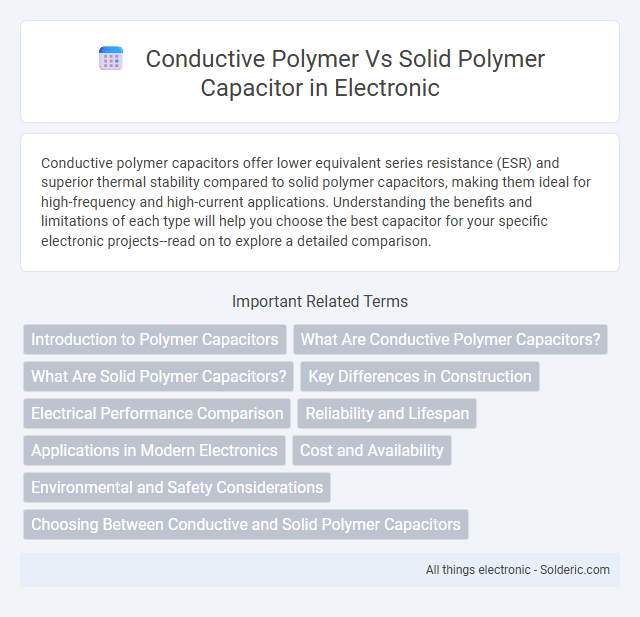Conductive polymer capacitors offer lower equivalent series resistance (ESR) and superior thermal stability compared to solid polymer capacitors, making them ideal for high-frequency and high-current applications. Understanding the benefits and limitations of each type will help you choose the best capacitor for your specific electronic projects--read on to explore a detailed comparison.
Comparison Table
| Feature | Conductive Polymer Capacitor | Solid Polymer Capacitor |
|---|---|---|
| Electrolyte Type | Conductive polymer (e.g., PEDOT) | Solid polymer electrolyte (e.g., PPy, PANI) |
| Equivalent Series Resistance (ESR) | Low ESR, better performance at high frequency | Very low ESR, superior high-frequency response |
| Capacitance Stability | Good stability over temperature and frequency | Excellent stability, less leakage |
| Leakage Current | Moderate leakage current | Lower leakage current, enhanced reliability |
| Operating Temperature Range | Up to 125degC | Up to 105degC to 125degC depending on design |
| Applications | Power supplies, audio amplifiers, voltage smoothing | High-performance power electronics, automotive, telecommunications |
| Reliability | Good, affected by polymer degradation | High reliability, stable over time |
| Cost | Moderate | Higher cost, advanced materials |
Introduction to Polymer Capacitors
Polymer capacitors use polymer electrolytes to offer low equivalent series resistance (ESR) and high capacitance stability compared to traditional electrolytic capacitors. Conductive polymer capacitors utilize a solid conductive polymer as the electrolyte, providing superior temperature performance and long life, while solid polymer capacitors employ a solid polymer film, ensuring enhanced reliability and lower leakage current. Your choice between conductive and solid polymer capacitors depends on application requirements such as frequency response, temperature range, and durability.
What Are Conductive Polymer Capacitors?
Conductive polymer capacitors utilize a conductive polymer as the electrolyte, offering low Equivalent Series Resistance (ESR) and excellent frequency response, ideal for high-performance applications. These capacitors provide greater stability and longer lifespan compared to traditional solid polymer capacitors, which use manganese dioxide or other solid electrolytes. Their superior electrical conductivity and robust thermal tolerance make conductive polymer capacitors preferred in power supply circuits, automotive electronics, and high-frequency devices.
What Are Solid Polymer Capacitors?
Solid polymer capacitors utilize a conductive polymer as the electrolyte, offering lower equivalent series resistance (ESR) and enhanced stability compared to traditional electrolytic capacitors. These capacitors feature a solid manganese dioxide or conductive polymer layer, providing superior thermal performance and longer lifespan. Solid polymer capacitors are ideal for applications requiring high ripple current tolerance and reliable performance in harsh environments.
Key Differences in Construction
Conductive polymer capacitors use a conductive polymer as the electrolyte, offering lower Equivalent Series Resistance (ESR) and better performance at high frequencies compared to solid polymer capacitors, which utilize a solid electrolyte made from doped polymers. Solid polymer capacitors often provide improved thermal stability and longer lifespan, making them suitable for applications requiring consistent performance under varying environmental conditions. Your choice depends on the trade-off between enhanced conductivity and durability needed for your specific electronic circuit.
Electrical Performance Comparison
Conductive polymer capacitors typically exhibit lower Equivalent Series Resistance (ESR) and higher ripple current ratings compared to solid polymer capacitors, resulting in better efficiency and thermal stability. Solid polymer capacitors, while offering improved leakage current and longer lifespan, generally have higher ESR, which can affect performance under high-frequency applications. Your choice between these capacitor types should consider the specific electrical performance needs, such as transient response and frequency range, to optimize circuit reliability.
Reliability and Lifespan
Conductive polymer capacitors offer higher reliability and longer lifespan compared to solid polymer capacitors due to their superior self-healing properties and better tolerance to high ripple currents. Solid polymer capacitors are more prone to degradation under thermal stress and voltage fluctuations, resulting in shorter operational life. Your choice of capacitor should consider the specific application environment to maximize reliability and durability.
Applications in Modern Electronics
Conductive polymer capacitors excel in high-frequency circuits and power supply filtering due to their low equivalent series resistance (ESR) and excellent thermal stability. Solid polymer capacitors, with their improved reliability and longer lifespan, are widely used in consumer electronics, automotive systems, and industrial equipment requiring robust performance. Your choice between these capacitors should consider the specific application's demands for ripple current handling, temperature range, and long-term durability.
Cost and Availability
Conductive polymer capacitors typically have a higher cost due to advanced materials and manufacturing processes, but they offer superior electrical performance and are widely available from multiple suppliers. Solid polymer capacitors generally provide a cost-effective alternative with good reliability, making them accessible for mass production and budget-sensitive applications. Market availability favors conductive polymer capacitors in high-performance electronics, while solid polymer types dominate cost-driven mainstream usage.
Environmental and Safety Considerations
Conductive polymer capacitors exhibit lower environmental impact due to their reduced use of hazardous materials compared to solid polymer capacitors, which often contain substances like manganese oxide that pose disposal challenges. These capacitors also offer enhanced safety features with reduced risk of thermal runaway and electrolyte leakage, minimizing fire hazards in electronic devices. Selecting conductive polymer capacitors supports sustainability efforts and compliance with stringent environmental regulations such as RoHS and REACH.
Choosing Between Conductive and Solid Polymer Capacitors
Choosing between conductive polymer and solid polymer capacitors depends on your application's requirements for performance and reliability. Conductive polymer capacitors offer low equivalent series resistance (ESR) and excellent ripple current handling, making them ideal for high-frequency circuits and power supply filtering. Solid polymer capacitors provide enhanced stability and longer lifespan under thermal stress, suited for environments demanding robust durability and consistent capacitance over time.
Conductive polymer vs solid polymer capacitor Infographic

 solderic.com
solderic.com